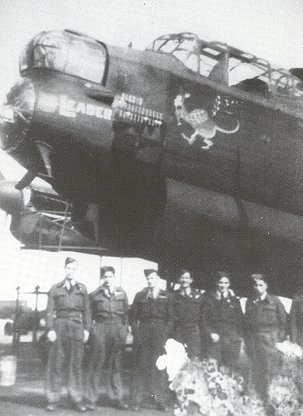
The story of Flight JB 607 "Leader" ...
From the 18th of November 1943 Berlin (the Big City), is the main target of the RAAF. Till the 25th of march 1944 the RAAF raids Berlin sixteen times. These sixteen attacks mean 9.111 sorties, during which 492 aircraft failed to return, and 954 were damaged. On the 29th of December 457 Lancasters took off for Berlin. JB607 was one of the 11 planes lost. It was a model B.III built bij AV. Roe in Chadderton.
On wednesday the 29th of December 1943 the second attack is at hand. There are thick clouds over Europe but with the skymarkers' help 460th squadron will find her way to Berlin. Thick clouds also means less German nightfighters.
The JB 607 AR-N 'Leader' of the 460 Squadron of the RAAF started from Binbrook at 17.03 hours for her part in this second raid on Berlin. The crew of seven is in their plane from around 15.30 hours. A flight to Berlin and back means about 6.30 to 8.30 hours of work, fear, elation and …...
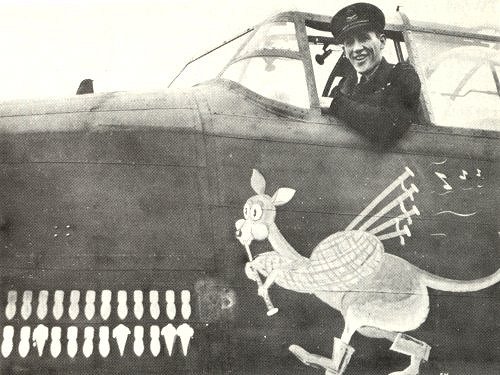 The Leader with Pilot Stan Ireland (?) in the cockpit
The Leader with Pilot Stan Ireland (?) in the cockpitThat day they start with 712 bombers; twenty-two of the RAAF from the Airbase Binbrook. 1.200 4-pounder incendiaries, 56 30-pounder incendiaries and a cookie of 4.000-pound are to be delivered. They have 8.000 liters of fuel on board for this mission. After their take-off from Binbrook they go to their formation point over Britain fly across the Channel, over the Netherlands to their initial point of attack in Germany. The crew of JB 607 makes her bomb run over Berlin in the fist wave. The 4th and 5th wave can see the target from 150 kilometers burning and glowing.
Back to their airbase their normal route lays between Hannover and Bremen. And then across a small part of the Netherlands, over the North Sea and back to Binbrook.
But it seems they are flying in another direction - a more southwestern course - because over Cologne JB 607 is 'bounced' by a German nightfighter, which opens fire at about 21.30 hours (according to Frank Seery his local British time). They are hit a first time by this nightfighter in the cockpit at a hight of about 19.000 feet. According to the 'skipper' Ireland, from a nightfighter.
They take a left turn to avoid more hits. But over Aachen, in direction Holland, they are hit again with a volley of shells by this or another nightfighter. Frank Seery (bomb aimer) survives this attack together with pilot Stan Ireland and engineer Billy Squire. But the plane is ablaze, the intercom and engines are out of order, the plane seems lost and they try to open the front escape hatch. But it jammes when the slipstream gets its grip on the hatch. At last Squire and Seery force the hatch open and while Seery bailes out, Squire gets back to the cockpit to inform Ireland who is trying to keep the plane away from building, looking for a site for an emergency landing. But within a split second after Seery bailed out the plane explodes.
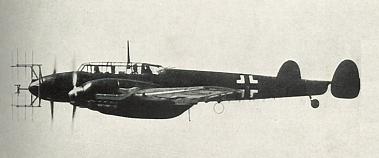 The Messerschmitt Bf110g Nightfighter ...
The Messerschmitt Bf110g Nightfighter ...This last fatal attack takes place over or near Aachen - some 60 kilometers west of Cologne - and the plane crashes in nearby Kerkrade some 10 km from the centre of Aachen. Pieces of the wreckage hit a farmhouse, fall in the orchyard and on the footballpitch of the boarding school of the Friars of Sint Franciscus in Kerkrade-Bleijerheide. The orchyard is on fire in no time. Other pieces of the wreckage are spread into the gardens of houses at the Nieuwstraat. The bodies of the crewmembers are scattered all over. They are gathered, put together in one coffin and at first buried in the cemetery of the Friars. People are glad that there are no more bombs on board that might explode.
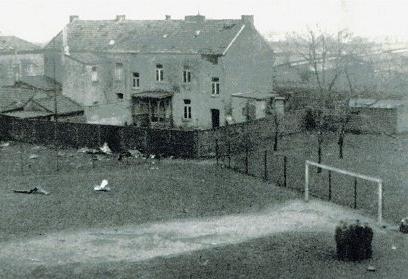 The orchyard after the crash of Flight JB607
The orchyard after the crash of Flight JB607The crash in the orchyard happened the 29th of December 1943 at 22.30 hours (local Dutch time). All crew but one died 60 years ago. The survivor - flight sergeant (bomb aimer) Frank Seery - escapes with his parachute and lands near the crashed plane where he hears ammunition exploding. He flies on foot to the south; direction France.
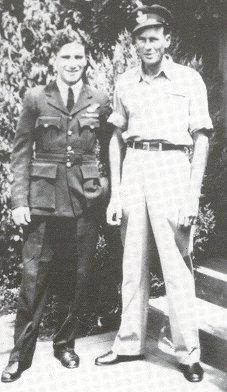 Frank Seery back home with his brother-in-law
Frank Seery back home with his brother-in-lawIt still is heavily clouded and it snows lightly. Around 8 o'clock next morning he is lost but welcomed by two 'hospitable' ladies in a farmhouse, but half an hour later he is handed over to two uniformed Germans. Probably he walked into Germany. From the Friars orchyard due south a matter of 50 meters. So he first goes to 'Dulag Luft' near Frankfurt am Main and from there - on the 18th of january 1944 - to Stalag IVD near Torgau at the Elbe river. Thus ends Frank Seery's 22nd mission over occupied Europe, the lives of six crewmembers and the JB607……
The six crewmembers who died that night are :
Stanley J. Ireland - (Pilot / age 30 / Pilot Officer / RAAF)
Ambrose E. Blight - (Navigator / age 29 / Pilot Officer / RAAF)
Maxwell H. Squires - (Gunner / age 20 / Flight Sergeant / RAAF)
Cyril Seddon - (Wireless operator / age 22 / Sergeant / RAF Vol. Res.)
Reginald J. Poulter - (Gunner / age 21 / Sergeant / RAF Vol. Res.)
William A. H. Squire - (Engineer / age 19 / Sergeant / RAF Vol. Res.)
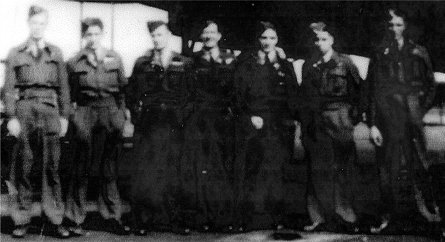 The crew of Flight JB 607 "Leader"
The crew of Flight JB 607 "Leader"Left to right: Seddon, Squires, Ireland, Blight, Seery, Poulter, Squire
They were at first buried just outside the Friars cemetery in Kerkrade ... just outside because back in those days the Friars didn't know if they were all Catholic. After the war they all were reinterred in cemetery of the Commonwealth War Graves Commission "Reichswald Cemetery" in Kleve (Germany).
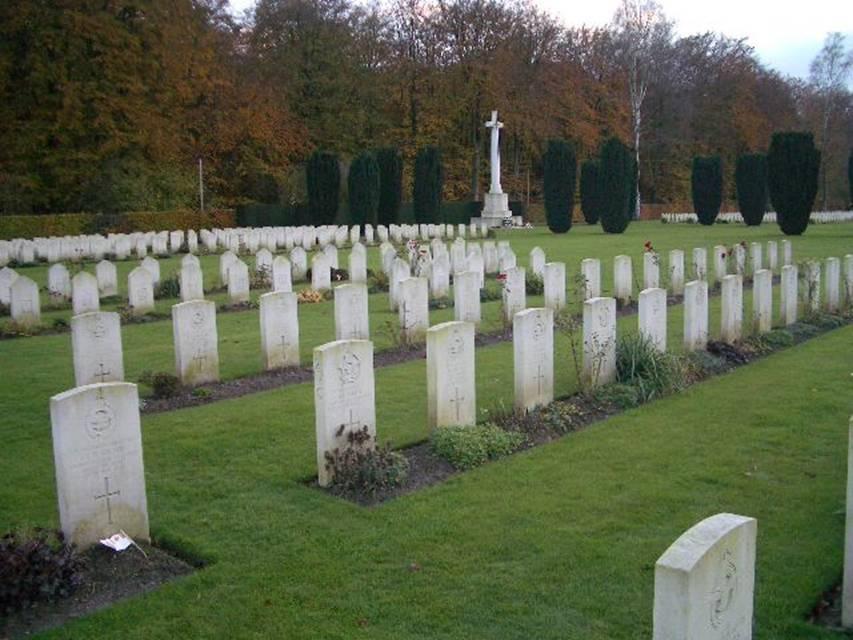 The Reichswald Cemetery at Kleve (Germany)
The Reichswald Cemetery at Kleve (Germany)At the friars a small memorial remembers these flyers that died on that 29th of December 1943. In november 1998 someone visited the friars cemetery and left a cross of poppies with a small card saying 'In memory of Sgt WAH Squire and his 5 mates'. At the friary nobody knows who left this reef and card. They suggest it was Frank Seery. But they are not sure. Who knows who this visitor was?
Special thanks to Ambrose Blight's nephew Peter Blight, to (the late) Mr. Frank Seery, to Wim Slangen, Peter Dunn (Ozatwar) and to the Franciscan Friars at Bleijerheide (Kerkrade).